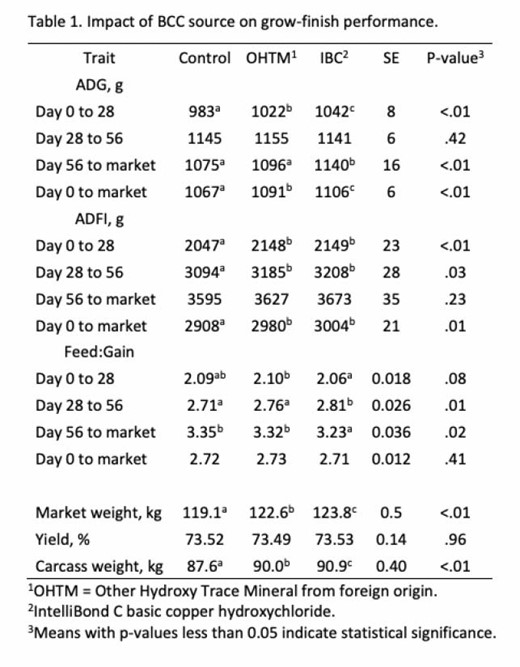-
PDF
- Split View
-
Views
-
Cite
Cite
Mark Knauer, Chris van de Ligt, PSIII-20 The Effects of Basic Copper Chloride Sources on Pig Grow-Finish Performance, Journal of Animal Science, Volume 100, Issue Supplement_2, May 2022, Pages 140–141, https://doi.org/10.1093/jas/skac064.240
Close - Share Icon Share
Abstract
The objective was to evaluate differences in grow-finish performance between 2 sources of basic copper chloride (BCC), IntelliBond C and another hydroxy chloride mineral (OHTM) BCC in the presence of a control diet. Pigs (n = 1,053) at the NCDA Tidewater Research Station were used. Sows were Landrace × Large White composites mated to Smithfield Premium Genetics’ Duroc boars. At 30.9 kg, gilts and barrows were randomly allocated within sex to one of 117 finishing pens (9 pigs per pen, .69 m2 per pig). Treatments included a control (15 ppm CuSO4), IntelliBond C (150 ppm Cu) and an OHTM Cu (150 ppm Cu). Treatments were fed from weaning to market and finisher entry to market in experiments 1 and 2, respectively. Pigs were individually weighed at d 0, 28, 56 and at market. Housing consisted of fully slatted floors and natural ventilation. Traits included pig weight, ADG, ADFI, Feed:Gain, body weight CV, carcass weight and yield. Experiment, barn location, sex and diet were included in statistical models. Pen was the experimental unit. Both sources of BCC outperformed the control diet, having increased (P < 0.01) ADG from d 0 to market driven by increased (P < 0.05) ADFI. Yet pigs fed IntelliBond C had greater (P = 0.01) ADG from d 0 to market when compared with those fed OHTM. The enhanced growth of IntelliBond C was driven by numerically greater average daily feed intake and improved feed efficiency. The improved gain resulted in a greater (P < 0.05) body weight at marketing and persisted in a greater (P < 0.05) hot carcass weight for basic copper chloride sources compared with CuSO4 and for IntelliBond C compared with OHTM Cu. Results suggest BCC enhances finishing throughput and that performance differences exist between BCC sources.




